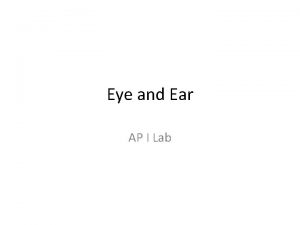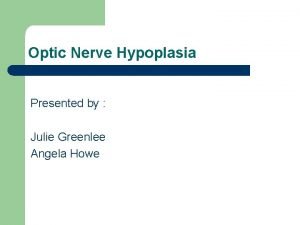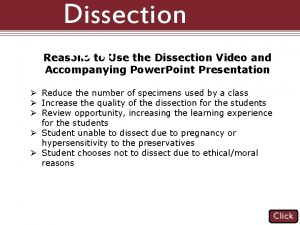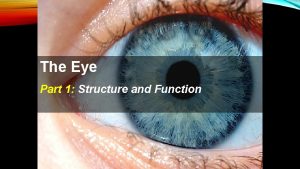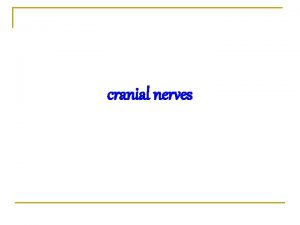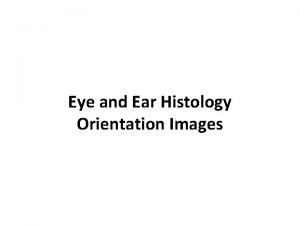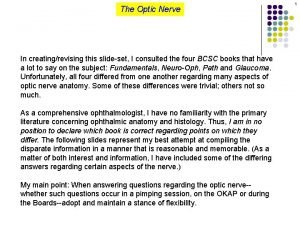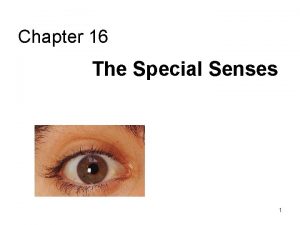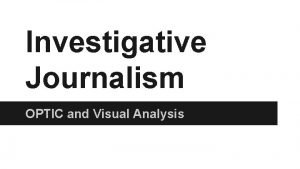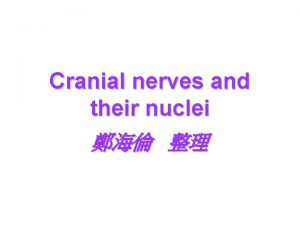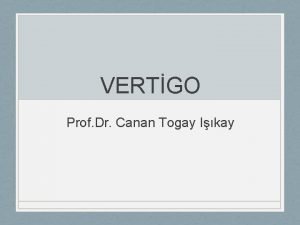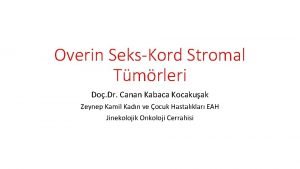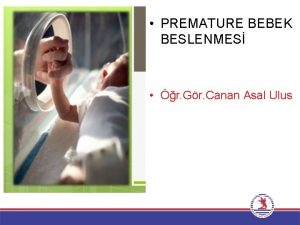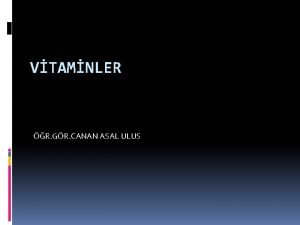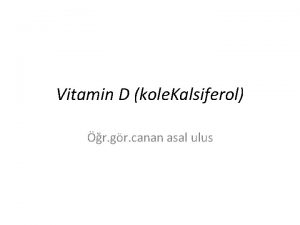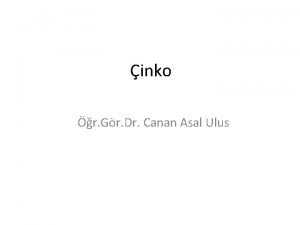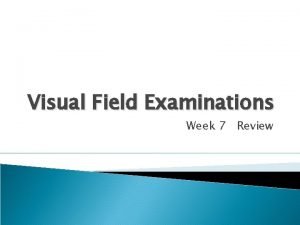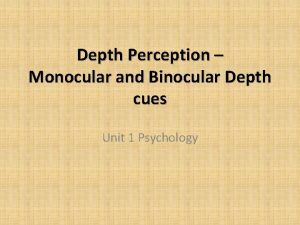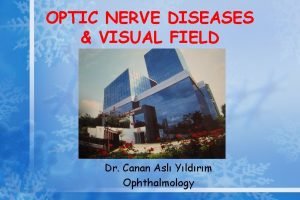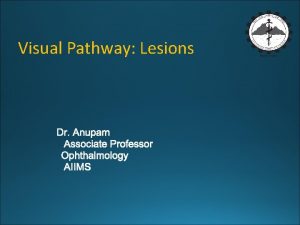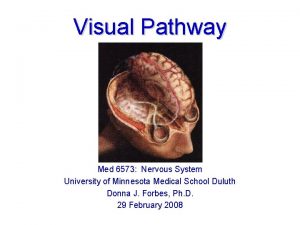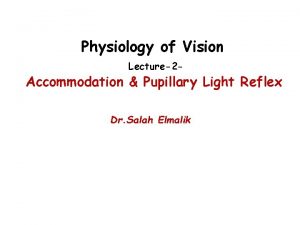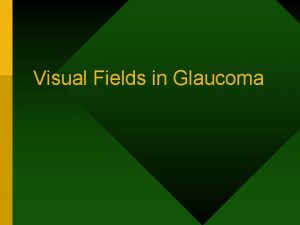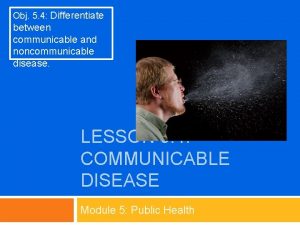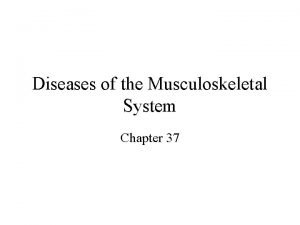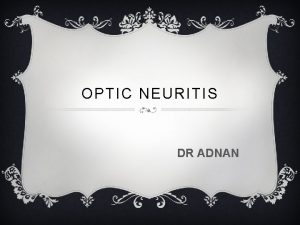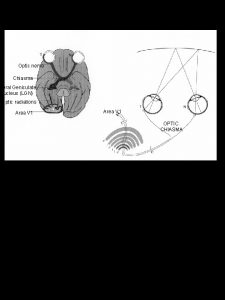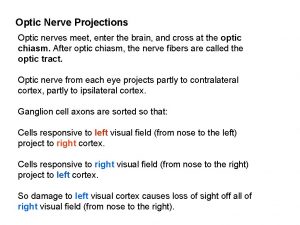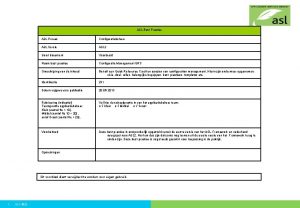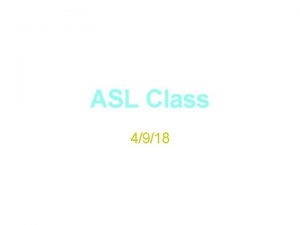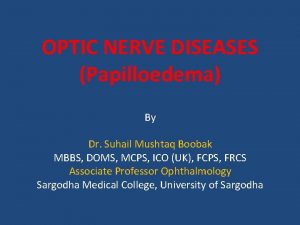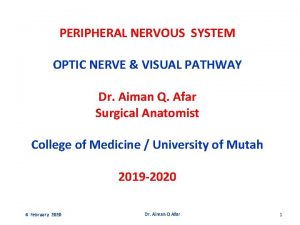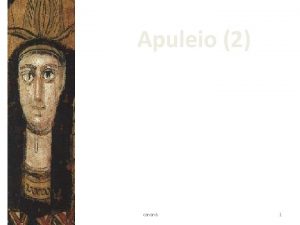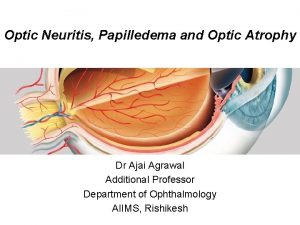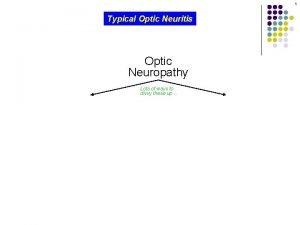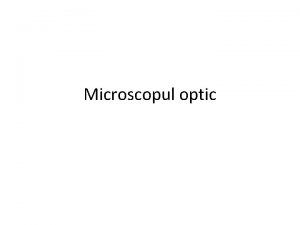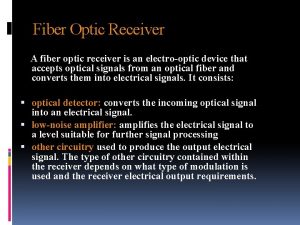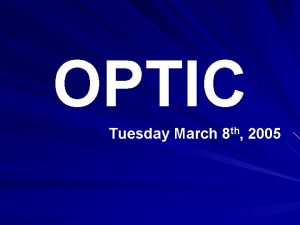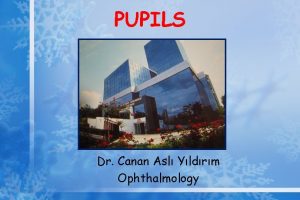OPTIC NERVE DISEASES VISUAL FIELD Dr Canan Asl



































































- Slides: 67

OPTIC NERVE DISEASES & VISUAL FIELD Dr. Canan Aslı Yıldırım Ophthalmology


Signs of optic nerve dysfunction • Reduced visual acuity • Afferent pupillary conduction defect • Dyschromatopsia • Diminished light brightness sensitivity

OPTIC NERVE DISEASES 1. Clinical features 2. Special investigations 3. Optic neuritis • Retrobulbar neuritis • Papillitis • Neuroretinitis 4. Anterior ischaemic optic neuropathy 5. Leber hereditary optic neuropathy

Clinical features • Reduced visual acuity • Visual field defects • Diminished pupillary light reactions • Impairment of colour vision • Diminished light brightness sensitivity

Uniocular light stimulus evokes bilateral and symmetric pupillary constriction.

Applied anatomy of afferent conduction defect Anatomical pathway Signs • Equal pupil size • Light reaction - ipsilateral direct is absent or diminished - consensual is normal 3 rd • Near reflex is normal in both eyes • Total defect (no PL) = amaurotic pupil • Relative defect = Marcus Gunn pupil

Optic disc changes Normal • • Retrobulbar neuritis Early compression Optico-ciliary shunts • • Optic nerve sheath meningioma Occasionally optic nerve glioma Swelling Papilloedema Papillitis and neuroretinitis AION • • • Atrophy • • • Postneuritic Compression Hereditary optic atrophies

Classification of optic neuropathies • Optic neuritis • • – Retrobulbar neuritis – Papillitis – Neuroretinitis Ischemic optic neuropathy Hereditary optic neuropathy Toxic optic neuropathy Post-infectious optic neuropathy

• Papilledema: bilateral, good central vision • Papillitis: inflamatory edema of the disc(anterior optic neuritis): unilateral, decreased VA, impaired color vision, afferent pupillary defect • Retrobulbar neuritis: loss of vision, normalappearing optic nerve and pain on movement of the eye

A. Optic neuritis Retrobulbar neuritis (normal disc) • • • Papillitis (hyperaemia and edema) Demyelination-most common • Viral infections and immunization in children (bilateral) Sinus-related (ethmoiditis) • Demyelination (uncommon) Lyme disease • Syphilis Neuroretinitis (papillitis, macular star) • Cat-scratch fever • Lyme disease • Syphilis

Special investigations MRI Orbital fat-suppression techniques in T 1 -weighted images Visually evoked potential Assessment of electrical activity of visual cortex created by retinal stimulation

Optic neuritis • • Women %74, men %34 %70 with multiple sclerosis Uhthoff’s phenomenon + Clinical features; -acute onset of monocular visual loss -periocular discomfort -frontal headache -impairment of colour vision

Multiple sclerosis A common idiopathic demyelination disorder of the CNS characterized by intermittent disturbances of neurological function Clinical features; • spinal cord lesions (weakness, stiffness, muscle spasms) • brain stem lesions (diplopia, nistagmus, ataxia, dysarthria) • hemisphere lesions (depression, dementia, hemianopia, hemiparesis) • transient phenomena (epilepsy, uhthoff’s phenomenon)

Uhthoff’s phenomenon • Sudden, temporary worsening of visual or other symptoms brought on by physical exercise or increase in body temperature

Diagnosis of Multiple sclerosis • Lumbar puncture • Evoked potential recordings • Magnetic resonance imaging (MRI)

B. Ischemic optic neuropathy 1. Non-arteritic 2. Arteritic

B 1. Non-arteritic AION Presentation • • • Age - 45 -65 years Altitudinal field defect Eventually bilateral in 30% (give aspirin) Acute signs • • Pale disc with diffuse or sectorial oedema Few, small splinter-shaped haemorrhages Late signs • • Resolution of oedema and haemorrhages Optic atrophy and variable visual loss

Non-arteritic AION • Monocular sudden, painless visual loss • Visual field defect (altitudinal hemianopia, arcuate defects, central scotoma) • Colour vision is diminished

FFA in acute non-arteritic ION Localized hyperfluorescence Increasing localized hyperfluorescence Generalized hyperfluorescence

Non-arteritic AION Central scotoma Altitudinal hemianopia Arcuate defect

B 2. Arteritic AION • • Affects about 25% of untreated patients with giant cell arteritis Severe acute visual loss Treatment - steroids to protect fellow eye Bilateral in 65% if untreated • • • Pale disc with diffuse oedema Few, small splinter-shaped haemorrhages Subsequent optic atrophy

Superficial temporal arteritis Presentation • • Age - 65 -80 years Scalp tenderness Headache Jaw claudication Polymyalgia rheumatica Superficial temporal arteritis Acute visual loss Special investigations • ESR - often > 60, but normal in 20% C-reactive protein - always raised • Temporal artery biopsy •

Histology of giant cell arteritis • Granulomatous cell infiltration • Disruption of internal elastic lamina • Proliferation of intima • Occlusion of lumen • High-magnification shows giant cells

C. Leber hereditary optic neuropathy Maternal mitochondrial DNA mutations Presents • • • Typically in males - third decade Occasionally in females - any age Initially unilateral visual loss Fellow eye involved within 2 months Bilateral optic atrophy Signs Disc hyperaemia and dilated capillaries (telangiectatic microangiopathy) • Vascular tortuosity • Swelling of peripapillary nerve fibre layer • Subsequent bilateral optic atrophy •

D. Toxic optic neuropathies • Toxic amblyopia -heavy drinkers and pipe smokers -slowly progressive, bilateral, visual impairment -loss of colour vision -centrocaecal scotoma -treatment: 1000 units hydroxycobalamin 10 wks, abstain from drinking-smoking

Toxic optic neuropathies • Ethambutol-ınduced optic neuropathy -sudden, dramatic visual loss -impairment colour perception -visual field temporal defect - drug is stopped (recovery time-12 mo)

E. Post-infectious optic neuritis • • • Acute papillitis Measles, mumps, chickenpox, immunization Acute severe visual loss in both eyes Headache, ataxia Treatment; unnecessary (spontaneous recovery) IV steroids for dramatic improvement

VISUAL FIELD

Maculopapillary bundle Nasal fibers Arcuate fibers Horizontal raphe Fovea






Visual Field Defects • • Scotoma Hemianopia Homonymous hemianopia Bitemporal hemianopia

SCOTOMA: an area of abnormal or absent vision within intact visual field HEMIANOPIA: loss of half the visual field (vertical or horisontal; altitudinal) HOMONYMOUS HEMIANOPIA: loss of either the right or the left half of the visual field in both eyes BITEMPORAL HEMIANOPIA: loss of right half of the visual field in the right eye and loss of the left half of the visual field in the left eye

Scotoma

Visual pathways wih associated field defects 1. Optic nerve Monoocular loss of vision 2. Optic nerve merging Monoocular loss of vision with chiasm associated with contralateral impairment of temporal field 3. Optic chiasm Bitemporal hemianopia 4. Optic tract Totaly homonymous hemianopia 5. Temporal lobe Upper homonymous hemianopia 6. Geniculate body Rare total homonymous hemianopia 7. Parietal lobe Lower homonymous hemianopia 8. Occipital lobe Variety of homonymous hemianopia


Anterior ischemic optic neuropathy (AION)

Altitudinal visual field defect due to central retinal artery inferior branch occlusion Anterior ischemic optic neuropathy

Bilateral optic nerve sheath meningioma

Optic chiasm • Craniopharyngioma • Hypohysis adenoma • Suprasellar meningioma • Aneurysms

Craniopharyngioma • Endocrinological disorders in children • LE Visual field defects in adults RE CF HM The posteriorly crossing fibres are most vunerable Craniopharyngioma

Craniopharyngioma

Hypophysis tumour LE RE Decussating fibres are most vunerable

Hypophysis adenoma

Hypophysis adenoma Bitemporal hemianopsia

Hypophysis adenoma

Meningioma LE RE Junctional scotoma Tuberculum Sella meningioma Sphenoid ridge meningioma Olfactory groove meningioma


Left homonymous hemianopsia

Right homonymous hemianopsia

Suprasellar aneurysm - optic tractus

Arteriovenous malformation Right homonymous hemianopsia


Posterior fossa tumour

• A right sided lesion producing left incongrous inferior quadranopsia

Occipital lobe lesion Left homonymous hemianopsia with macular sparing

Cortical blindness Vascular infarct LR+, retina normal Central vision preserved




Summary - Visual Field Defects • Central scotoma : optic nerve lesion • Bitemporal field defect : chiasmal disease • Homonymous visual field defect : retrochiasmal damage to the optic tracts, radiations, occipital cortex • Pituitary adenoma : bitemporal hemianopia • Stroke : homonymous hemianopia

Summary - Visual Field Defects

• Any questions ?
 Optic nerve
Optic nerve Optic nerve hypoplasia treatment
Optic nerve hypoplasia treatment Cow eye pupil
Cow eye pupil Optic nerve
Optic nerve Optic nerve names
Optic nerve names Inner ear histology
Inner ear histology Optic nerve length
Optic nerve length Retina and optic nerve
Retina and optic nerve Optic strategy visual communication guy
Optic strategy visual communication guy Optic visual analysis
Optic visual analysis Visual investigative analysis
Visual investigative analysis Trigeminal nerve which cranial nerve
Trigeminal nerve which cranial nerve Canan togay ışıkay
Canan togay ışıkay Luteoma kimlerde görülür
Luteoma kimlerde görülür Canan asal ulus
Canan asal ulus Canan citil akyol
Canan citil akyol Canan asal ulus
Canan asal ulus Canan asal ulus
Canan asal ulus Canan asal ulus
Canan asal ulus Canan asal ulus
Canan asal ulus Canan asal ulus
Canan asal ulus Meslek etiği canan yılmaz
Meslek etiği canan yılmaz Vitamindir
Vitamindir Dr canan kabaca kocakuşak kimdir
Dr canan kabaca kocakuşak kimdir Canan karaca
Canan karaca Canan asal ulus
Canan asal ulus Field dependent and field independent
Field dependent and field independent Distinguish between magnetic and nonmagnetic materials
Distinguish between magnetic and nonmagnetic materials Electric field and magnetic field difference
Electric field and magnetic field difference Magnetic field
Magnetic field Individual differences factors
Individual differences factors Waveguide cutoff frequency
Waveguide cutoff frequency Data types and field properties
Data types and field properties Field dependent vs field independent
Field dependent vs field independent Relative vs absolute scotoma
Relative vs absolute scotoma Visual field digest
Visual field digest Binocular cues definition psychology
Binocular cues definition psychology Hyperfluorescence
Hyperfluorescence Visual field digest
Visual field digest Right visual field
Right visual field Esterman efficiency score driving
Esterman efficiency score driving Visual field digest
Visual field digest Optic tract lesions
Optic tract lesions Visual fields
Visual fields Lateral geniculate body
Lateral geniculate body Visual field digest
Visual field digest Temporal island of vision
Temporal island of vision Persamaan pemrograman visual dan pemrograman konvensional
Persamaan pemrograman visual dan pemrograman konvensional Chapter 8 cardiovascular system
Chapter 8 cardiovascular system Quality guru
Quality guru Certain infectious and parasitic diseases
Certain infectious and parasitic diseases Monocyte derived dendritic cells
Monocyte derived dendritic cells Epidemiological triad of malaria
Epidemiological triad of malaria Non communicable diseases
Non communicable diseases Venn diagram of communicable and non-communicable diseases
Venn diagram of communicable and non-communicable diseases What conditions do fungal organisms favor for growth
What conditions do fungal organisms favor for growth Chapter 32 childhood communicable diseases bioterrorism
Chapter 32 childhood communicable diseases bioterrorism Diseases in civil war
Diseases in civil war Major nutritional deficiency diseases in emergencies
Major nutritional deficiency diseases in emergencies Diseases of the musculoskeletal system
Diseases of the musculoskeletal system Waterwashed diseases
Waterwashed diseases Diseases spread by columbian exchange
Diseases spread by columbian exchange Nutritional diseases
Nutritional diseases Examples of macronutrients elements
Examples of macronutrients elements Perianal pruritus
Perianal pruritus Tronsmo plant pathology and plant diseases download
Tronsmo plant pathology and plant diseases download Chapter 21 mental health diseases and disorders
Chapter 21 mental health diseases and disorders Section 19-3 diseases caused by bacteria and viruses
Section 19-3 diseases caused by bacteria and viruses
